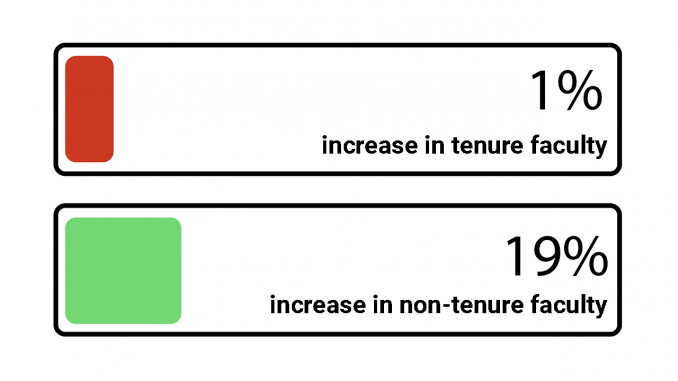
For the past two and a half years, Mary Stricker has juggled teaching three to four courses while completing autoethnography research.
“I don’t get much done during the regular semester,” said Stricker, an associate professor of sociology.
As a full-time, non-tenure track faculty who has worked at Temple University for 15 years, Stricker has less time than her tenured or tenure-track colleagues to focus on doing research because she has a larger course load.
The number of non-tenure track faculty at Temple has increased while the number of tenure-track or tenured professors barely budged in recent years, mirroring a shift in the composition of college educators across the country.
Temple added 206 non-tenure track faculty between 2013 and 2017, an increase of 19 percent, while tenured or tenure track faculty only increased by 13 members, or one percent, during the same period, according to the university’s annual fact books.
The proportion of non-tenure track faculty at universities surveyed by the American Association of University Professors increased from 10 percent in 2008 to 27 percent in 2018 nationwide, according to The Chronicle for Higher Education.
“What you have now are all these extremely talented full-time non-tenure track faculty who are doing a lot of the teaching,” said Steve Newman, president of Temple Association of University Professionals, which represents all faculty, librarians and academic professionals at the university.
“They do a lot of service, some of them are even chairs of the department, but they lack the job security that comes with tenure,” Newman added.
New Jersey was the first state to give professors tenure in 1910, Time Magazine reported. It granted fair dismissal rights to college professors. Today, tenure is still used to protect faculty members’ academic freedom by allowing them to permanently hold their positions.
“Tenure allows you to have greater academic freedom, pursue research that you want to pursue regardless of whether it makes the university look bad or not,” said Will Jordan, an associate professor of policy, organizational and leadership studies.
“It allows us to teach what we believe as scholars,” Jordan added.
Kevin Delaney, vice provost of faculty affairs, said that over the last five to 10 years, Temple has added more non-tenure track faculty than tenure track or tenured faculty because of high costs of research. Expenses for a single faculty member’s research project can range between $300,000 and $1,000,000, he said.
“A tenure track faculty member is expected to have a major research agenda, a major set of research accomplishments they are trying to achieve, as well as being very good teachers,” Delaney added. “A non-tenure track faculty may be hired often just to mainly to do teaching and instruction, so then they don’t have a big research agenda that’s expected of them.”
However, in order to secure tenure track positions, academics must build up their resumes, Newman said.
“Let’s say you’re lucky enough to get a full-time but non-tenure track gig, you’re teaching generally four classes a term,” Newman said. “So you’re grading a huge number of papers. How are you gonna make the time to do the publishing you need to do to make you viable for a tenure-track job?”
“I don’t think anyone doesn’t want to pursue tenure,” said Ben Curttright, an adjunct professor in the Department of English and chair of the Adjunct Constituency Council of TAUP. “Without genuine job security, you don’t have academic freedom, and the way that genuine job security is provided in academia is through tenure.”
To prevent another decline in hiring, TAUP proposed increasing the number of tenure track faculty by one percent each year in their August negotiations with the university. Temple has not agreed to this demand, Newman said.
“If we were arbitrarily gonna say that we were going to increase by one percent, we would then have to mandate each individual school and college to do certain numbers and quotas for that,” Delaney said. “To me, it’s just not a great way to manage things.”


Be the first to comment